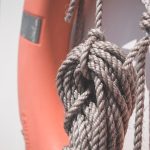You want a boat cover that withstands sun, resists salt, and prevents mildew. Choosing the right fabric means balancing durability, breathability, and cost. Acrylic and polyester often come up in the conversation, but which one truly holds up in harsh marine conditions? Understanding the strengths and weaknesses of each material can save you from premature wear and costly replacements. Let’s explore what makes a fabric stand out for your boat’s protection.
Table of Contents
Key Takeaways
- Acrylic fabric offers superior UV resistance, excellent mildew resistance, and color retention in harsh sun and salty marine environments.
- Vinyl-coated fabrics provide outstanding waterproofing and salt resistance but are heavier and less breathable, risking trapped moisture.
- Polyester is strong and cost-effective but degrades faster under prolonged sun exposure and absorbs more moisture, increasing mildew risk.
- Breathable fabrics balance water resistance and air flow to prevent moisture buildup and mildew beneath the boat cover.
- Durable boat cover fabrics should combine UV protection, mildew resistance, and ease of maintenance to maximize lifespan and performance.
Key Qualities of Durable Boat Cover Fabrics
When you choose a boat cover fabric, durability should be your top priority because it directly affects how well your boat stays protected over time.
You want a fabric that resists tearing, fading, and mildew, especially since your boat faces harsh sun and saltwater conditions. Look for materials offering strong UV protection to prevent sun damage and extend the cover’s lifespan.
Additionally, consider how easy fabric maintenance will be—choosing a fabric that cleans up quickly and doesn’t trap moisture reduces the risk of mildew growth.
Durable fabrics also maintain their strength despite frequent use and exposure, so you won’t need to replace your cover often.
Prioritizing these qualities guarantees your boat stays safe, and your investment lasts longer without constant upkeep.
Comparing Acrylic and Polyester for Marine Use
Although both acrylic and polyester fabrics are popular choices for boat covers, they offer distinct advantages and drawbacks that you should consider for marine use.
Acrylic benefits include excellent resistance to UV rays and fading, which means your cover will maintain its color and strength even under intense sun exposure. It also resists mildew well, making it great for damp, salty environments.
On the other hand, polyester is strong and affordable, but its polyester drawbacks limit its marine performance. It tends to degrade faster under prolonged sun exposure and can absorb more moisture, leading to mildew issues if not properly treated.
When choosing between the two, weigh acrylic benefits against polyester drawbacks to guarantee you pick a fabric that offers lasting protection for your boat.
Advantages and Limitations of Vinyl-Coated Fabrics
Acrylic and polyester each have their strengths and weaknesses, but vinyl-coated fabrics offer a different set of benefits that might suit your boat cover needs better.
Vinyl benefits include exceptional waterproofing and strong resistance to UV rays, salt, and mildew. However, you should also consider some vinyl drawbacks before choosing it.
Here’s what you need to know about vinyl-coated fabrics:
- Outstanding durability against harsh marine environments
- Superior water resistance keeps your boat dry
- Easy to clean and maintain
- Less breathable, which may trap moisture underneath
- Can be heavier and less flexible than acrylic or polyester
The Role of Breathability in Preventing Mildew
Since boat covers often face moisture from rain and humidity, breathable fabrics play an essential role in preventing mildew growth.
When you choose a cover with good fabric ventilation, you allow trapped moisture and condensation to escape, reducing the damp environment where mildew thrives.
Breathability helps keep your boat dry underneath the cover, enhancing mildew prevention without sacrificing protection from external elements.
You want a fabric that balances water resistance with air permeability to maintain this airflow.
Without proper ventilation, moisture buildup can lead to mold and mildew, damaging both the cover and your boat.
Cost Versus Longevity: Choosing the Best Fabric for Your Boat Cover
Understanding how fabric breathability helps protect your boat is just one part of selecting the right cover. When choosing, you’ll want to perform a thorough cost analysis alongside a longevity assessment to make the best investment.
Fabric breathability is key, but cost and longevity are crucial when choosing the best boat cover.
Here’s what to take into account:
- Initial purchase price versus expected lifespan
- Resistance to UV rays, salt, and mildew
- Maintenance requirements and associated costs
- Warranty and manufacturer reputation
- Environmental factors where you store your boat
Durable fabrics might cost more upfront but often save you money over time by requiring fewer replacements.
Balancing cost and durability guarantees you get a cover that protects without breaking your budget. By focusing on these key points, you’ll confidently select a fabric that offers lasting protection and the best value for your boat.
Frequently Asked Questions
How Should I Clean and Maintain My Boat Cover Fabric?
Like a painter caring for their canvas, you should use gentle cleaning techniques and regular maintenance tips—rinse with mild soap, avoid harsh chemicals, air dry thoroughly, and store your cover properly to keep it lasting longer and looking great.
Can Boat Covers Be Custom-Made for Unusual Boat Shapes?
You can definitely get custom cover options tailored for unique boat shapes. Many manufacturers specialize in creating snug fits that protect your boat perfectly, ensuring durability and style no matter how unusual your boat’s design may be.
What Hardware or Fasteners Work Best With Durable Boat Covers?
You’ll want corrosion-resistant fastener materials like stainless steel or marine-grade plastic for your boat cover. Secure attachment methods include stainless steel snaps, adjustable straps, and reinforced grommets to guarantee a tight, durable fit.
Are There Eco-Friendly Fabric Options for Boat Covers?
You can choose eco-friendly boat covers made from sustainable materials like organic cotton blends or biodegradable options such as hemp. These fabrics reduce environmental impact while still offering decent durability, so you’re protecting both your boat and the planet.
How Do Temperature Extremes Affect Different Boat Cover Fabrics?
You’ll notice temperature impact varies; extreme heat can weaken fibers, while cold may cause stiffness or cracking. These changes reduce fabric longevity, so you’ve got to choose materials that handle temperature swings without losing strength or flexibility.
- Tetron White Fabric: Style and Application Guide - June 17, 2025
- Tetron Silk Fabric: A Comprehensive Guide - June 17, 2025
- Tetron Rayon Fabric: Features and Applications - June 17, 2025






